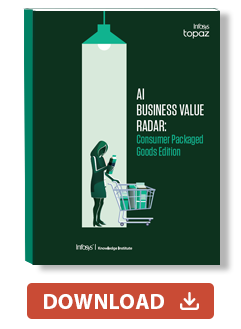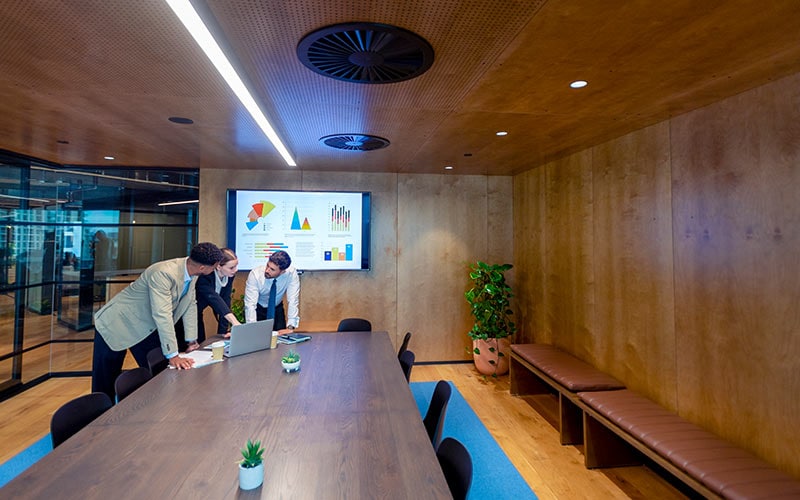
Insights
- CPG companies are still early in their AI journey, with plenty of growth potential.
- They face challenges like transformation demands, skill gaps, and misaligned investments.
- Yet, there are clear opportunities to drive meaningful business value.
- Success depends on strong tech foundations and a prepared, aligned workforce.
- Companies that scale AI while adapting will gain lasting competitive advantage.
Executive summary
In an era where digital transformation is no longer optional, artificial intelligence (AI) is emerging as the definitive competitive advantage — and this is very much the case for the consumer packaged goods (CPG) sector. The products we consume daily, from packaged foods to personal care items, are increasingly being developed, manufactured, marketed, and distributed with AI involved in the process.
Research from Infosys shows that implementing AI helps industries stay competitive in terms of innovation and efficiency. For its AI Business Value Radar, Infosys surveyed 3,798 business leaders globally. Of those, 250 were from the CPG industry. And the CPG sector is generating value from AI: According to the Infosys research, 55% of AI use cases in CPG generate tangible business value, on par with the industry average (Figure 1).
Figure 1. More than half of AI use cases generate business value
Source: Infosys Knowledge Institute
Cybersecurity and resilience are the top use case categories within which the CPG companies surveyed are pursuing AI, followed by marketing and IT, operations, and facilities (Figure 2).
Figure 2. Popularity and viability of functional use case categories
Source: Infosys Knowledge Institute
CPGs are vulnerable to cyberattacks due to their heavy reliance on e-commerce and digital channels. Leveraging AI is essential to proactively detect threats, safeguard systems, and ensure secure consumer interactions.
AI use in IT, operations, and facilities likely stems from a broader push for cost takeout. AI can accelerate tasks like software development, coding, data analysis, and process optimization, often completing them efficiently, and faster than human teams. By automating these functions, companies can streamline workflows, see productivity benefits, and potentially reduce headcount in these areas, which could likely be the reason for their focus.
The IT, operations, and facilities category is less prioritized than in other industries and seems to be less viable (in other words, less likely to generate business value) or less likely to succeed than in other industries but still enjoys an average rate of success.
The transition to AI for CPGs isn’t happening in isolation. It’s occurring against a backdrop of market volatility due to economic uncertainty, decelerating global growth, trade tensions from tariff hikes, evolving consumer preferences, supply chain disruptions, and sustainability pressures. AI offers CPG companies the potential to impact every aspect of the value chain – from creating personalized products that meet individualized consumer needs to optimizing pricing strategies that maximize margins in fluctuating markets.
CPG organizations that successfully harness AI are seeing transformative benefits, including increased operational efficiency, enhanced product innovation, reduced time to market, and strengthened consumer relationships.
Yet despite this promise, many CPG companies struggle to move beyond experimental AI pilots to enterprisewide deployment that delivers sustainable business value. The path to AI success in the CPG sector is challenging and requires specific approaches tailored to the industry’s distinct characteristics.
How AI is reshaping CPG
The Infosys research identified several successful AI implementations in the CPG industry. These case studies illustrate how companies are delivering significant business value through AI.
Personalized products
Product development was found to be the most viable category of AI use case (Figure 3), and personalized product development is a leading AI opportunity for CPG companies. CPGs have successfully implemented AI to personalize product formulations and features based on consumer preferences and behavior patterns. For example, Coca-Cola used AI to analyze data from its Freestyle machines — self-service soda fountains that track customer preferences. These implementations typically involve analyzing consumer data to identify personalization opportunities, using AI to develop product variations tailored to different consumer segments, and implementing flexible manufacturing processes that can accommodate personalized production.
Figure 3. CPG companies employ AI effectively more often in product development
Source: Infosys Knowledge Institute
New product launches
When examining CPG AI use cases, loyalty programs and AI-driven new product launches show evidence of producing business value more often than average (Figure 4). CPG companies have used AI to predict market reception for new products with greater accuracy, optimize launch timing and geographic sequencing, personalize marketing for different consumer segments, and adjust production and distribution based on real-time market feedback.
Figure 4. Spending adjusted viability for industry-specific use cases lackluster in CPG
Source: Infosys Knowledge Institute
Smart, sustainable packaging
Smart and sustainable packaging is another viable AI use case for CPG (refer to the middle column of Figure 4). Successful implementations have enabled companies to design packaging that minimizes environmental impact while maintaining product protection. It also allows them to incorporate smart features such as near-field communication (NFC) or QR codes to collect data, provide usage information, and optimize packaging materials and designs for different distribution channels and market segments. These implementations show how AI can help CPG companies address growing consumer and regulatory pressure for sustainability while also enhancing product functionality and brand differentiation.
Loyalty optimization
Another successful AI application identified in the research is loyalty program optimization (refer to the middle column of Figure 4). This application helps CPG companies personalize rewards and incentives based on individual consumer preferences and behaviors, predict and prevent consumer churn through proactive engagement, and optimize program economics to maximize consumer value while controlling costs. This way, AI can transform traditional loyalty programs into sophisticated consumer engagement platforms that drive increased purchase frequency and share of wallet.
Cashflow optimization
This is a highly viable finance-related use case for CPG companies. Successful implementations in this area have enabled companies to predict cash requirements with greater accuracy across complex global operations, optimize working capital by adjusting inventory levels, payment terms, and production schedules, and identify and address potential cashflow issues before they materialize. This use case demonstrates the value of AI in financial management for CPG companies, which often face complex cash flow challenges due to seasonal demand, commodity price fluctuations, and extended supply chains.
Complexities of AI integration
Despite the significant potential of AI in the CPG industry, companies face numerous challenges when implementing AI solutions. The Infosys research reveals several key barriers that are particularly acute in the CPG sector.
High transformation required
One of the most significant findings from Infosys’ AI Business Value Radar 2025 research is that CPG companies face exceptionally high transformation requirements to successfully implement AI. Unlike some industries where AI can be deployed with minimal disruption to existing processes, CPG implementations typically require substantial restructuring. The data reveals that almost all CPG use cases require more transformation — that is, changes across areas such as the operating model, technical architecture, and data structure — to make them viable (refer to Figure 5, third column). This poses a challenge for organizations with entrenched legacy systems and traditional operational approaches.
Figure 5. CPG use cases require more transformation
Source: Infosys Knowledge Institute
Workforce preparedness gaps
Infosys’ research has identified that preparing workforces for AI is a critical factor for successful implementation. Respondents were grouped into four archetypes based on which of the following definitions matched their employee engagement with AI:
- Watchers: Organizations with minimal engagement with employees on AI, and limited or no training, education, or change management initiatives.
- Explorers: Companies taking initial steps to address AI with limited change management practices; employees have minimal involvement or support in understanding AI’s role.
- Pathfinders: Organizations with regular training and educational programs on AI and growing employee engagement.
- Trailblazers: Companies fully engaged in continuous AI training, education, and change management, with employees fully supported in understanding and adapting to AI.
The research shows that CPG companies are lagging other sectors, with fewer trailblazers than other industries (Figure 6). This suggests that CPG companies are still in the learning stage, with few having mastered AI.
Figure 6. Significantly fewer trailblazers in CPG
Source: Infosys Knowledge Institute
CPG companies have been cautious about supporting employees in adopting AI through focused initiatives such as training and change management, uncertain about where their capital might be needed as geopolitical challenges around the US imposition of tariffs prevailed. However, AI can be a powerful tool to navigate tariff-related uncertainties — enhancing revenue growth management, improving demand and supply planning, and providing end-to-end supply chain visibility to mitigate disruptions in the movement of goods and services. This could also affect their efforts toward workforce preparedness by helping with personalized training tailored based on employee roles.
Spending and viability
Another key challenge identified in the research is the misalignment between spending and viability in many CPG AI initiatives. The data shows a strong trend between the amount that has been spent on each CPG use case and the relative viability (Figure 7).
Figure 7. Relatively high spending offsets viability gains
Source: Infosys Knowledge Institute
For example, the research points out that product development use cases (personalized product development) are highly viable but require more transformation than average, and more spend. Similarly, cashflow forecasting optimization (finance) is very viable but requires lots of transformation (Figure 8), which might be one of the reasons finance use cases are less popular.
Figure 8. Relative required transformation versus viability
Source: Infosys Knowledge Institute
Alignment challenges
The research reveals interesting patterns in use case adoption within CPG companies that suggest potential alignment issues between IT and business functions. Notably, significantly fewer CPG respondents indicated they were pursuing use case categories in IT, operations, and facilities compared to respondents in other industries. This could be because these functions tend to be seen as support areas rather than key growth drivers. CPG companies typically channel their AI investments toward consumer-facing activities such as marketing, product development, and demand forecasting, where the returns are more direct and measurable in terms of revenue and competitive advantage.
At the same time, while manufacturing use cases are more popular with our CPG respondents than with the other industries as a whole, there appears to be a disconnect in areas like product development, which, though highly viable, has a fairly low adoption rate. This indicates potential challenges in aligning IT resources with business priorities, possibly stemming from organizational silos or differing perspectives on value drivers between technical and business teams.
Integration complexities
The CPG industry faces some specific challenges in AI implementation. Although AI use case success in the CPG industry is virtually indistinguishable from the average, CPG companies can achieve much higher viability scores when they transform their operating model and data architecture.
The data also reveals that most CPG use cases have an average rate of success (Figure 9). This might be due to the industry facing issues related to legacy technology that can hinder the smooth deployment and scaling of AI, and hiring and retaining AI talent, which are necessary factors for AI success.
Figure 9. AI use cases for CPG companies have an average rate of success
Source: Infosys Knowledge Institute
Additionally, sustainability use cases appear to be less successful for CPG companies than they do in other industries (Figure 2), which could be because sustainability for these companies is more about improving packaging and reusing goods and AI might not play much of a role in these areas. This highlights how industry-specific factors can create unique implementation challenges.
The path to AI success in the CPG sector is challenging. Addressing the significant barriers to AI adoption in the CPG industry requires strategic, focused approaches that recognize the unique nature of the sector in terms of picking the right use cases, fostering responsible AI, having an engaged workforce, upskilling talent, and building the right culture for AI.
The way forward
Prioritize transformation
CPG companies should conduct a transformation readiness assessment and evaluate their organizations’ current data infrastructure, technical architecture, and operating model to identify gaps that need to be addressed before scaling AI initiatives. They should establish robust data governance practices that ensure data quality, accessibility, and compliance — critical foundations for successful AI. CPG companies should also establish a dedicated function to coordinate transformation efforts across the organization, ensuring alignment across different business functions, and preventing siloed initiatives and duplication. Additionally, they should implement governance structures and a centralized AI task force to ensure responsible AI.
By prioritizing transformation preparedness, CPG companies can address one of the most significant barriers to AI success identified in the research.
Align investment with value
To address the misalignment between investment and viability, CPG companies need more sophisticated approaches to AI investment prioritization. They must create a portfolio approach to AI investments that explicitly considers both viability and the transformation effort that’s needed. They should increase investment and reallocate resources toward areas identified as highly viable in research, such as product development and marketing.
Agentic AI, a form of AI that deploys autonomous systems that can make decisions and perform tasks without human intervention, being a low-cost, low-effort, and highly viable use case, as identified by Infosys research, enables organizations to experiment with AI in a practical way, supporting human-machine collaboration and paving the way for gradual, scalable adoption.
CPGs should also develop more sophisticated return on investment (ROI) models that account for both direct financial returns and strategic value creation, recognizing that some high-value AI implementations could have longer payback periods. This can help CPG companies make more informed investment decisions, directing resources to areas with the highest potential for business value creation.
Build workforce development
To address the workforce preparedness gap identified in the research, CPG companies must invest in developing their employees’ AI capabilities. They can do this by creating targeted training initiatives that address the specific needs of different roles from executives to frontline workers.
They must incorporate formal change management methodologies into all AI deployments, focusing on building understanding, addressing concerns, fostering acceptance, and creating the right culture for AI. They need to create feedback mechanisms for employees to provide input on AI initiatives, helping to refine implementations and increase acceptance. They should also integrate AI skills development into performance objectives and career advancement paths.
By focusing on workforce development, CPG companies can move from the watchers and explorers categories into the trailblazers who demonstrate significantly higher success rates in AI implementation.
Foster collaboration
To overcome any IT-business alignment challenges, CPG companies should implement structures and processes that promote closer collaboration. They can do this by establishing cross-functional AI teams that bring together IT specialists and business domain experts to jointly develop AI solutions. They should adopt product management methodologies for AI initiatives, focusing on business outcomes rather than technical specifications. They should develop shared success metrics that align IT and business objectives, ensuring both groups are working toward common goals.
By fostering closer IT-business collaboration, CPG companies can address the adoption gaps identified in the research, particularly in high-potential areas like product development.
Conclusion
The CPG industry is still in the early stages of AI maturity, with significant room for growth and improvement. While CPG companies face significant challenges in AI implementation — including high transformation requirements, workforce preparedness gaps, and misalignment between investment and viability — they also have clear opportunities to create substantial business value. CPG executives must prioritize both the technical foundations of AI, which is data architecture, technology infrastructure, and integration capabilities, and the human dimensions of change, including workforce development, organizational alignment, and cultural adaptation.
As the AI landscape continues to evolve, CPG companies that develop the capability to deploy AI at scale while continuously learning and adapting will create sustainable competitive advantage.
“For CPG companies to truly benefit from AI, they need to lay a solid foundation — upgrading their data systems, reinforcing governance, and aligning efforts across teams,” says Sachin Jangam, managing partner, consumer goods, retail, and logistics at Infosys Consulting.
He adds: “Success is dependent on more than just tools. It requires organizational readiness to scale AI in a responsible, coordinated way. Taking a portfolio view of AI investments, based on both business potential and effort required, helps direct funding to the most impactful areas. Companies must equip their people through tailored training, career integration, and change management to confidently work alongside AI. Strengthening the connection between IT and business teams is also essential. Those who build strong technical capabilities and a culture ready for AI will be the ones to lead the future of the industry.”
Appendix A: Use cases
Based on interviews with subject matter experts and desk research, we collated 55 use case types across 14 categories (Figure A1). We similarly collated 77 industry-specific use case types across 15 industry sectors (Figure A2). All these use case types are themselves at a level of abstraction higher than a specific use case, to make the survey manageable — but they are also relevant for all respondents. The survey asked respondents to select up to five functional categories out of 14 (Figure A1) where their companies are pursuing AI.
Figure A1. Functional categories and their use case types
Source: Infosys Knowledge Institute
Respondents provided details on these categories, which were the top five that their company is already interested in. As such, this is a self-selecting sample. In Figure 1, for example, we would typically expect far more projects that had failed, been canceled, or been in pilots for what is an early stage and experimental technology. Each category had between two and six common use case types (for example, product recommendation use cases in the sales and retail category). For each use case type within a category, respondents were asked about the stage of implementation of their initiative(s). Options for this question were: No plans to implement; planning; created proof of concept or pilot; canceled before deployment; deployed, not generating business value; canceled after deployment; deployed, generating some business value; deployed, achieving most or all objectives. Respondents were then asked about the amount of spending for that use case type to date (from any start date). This was followed by questions about the amount of operational or business model change as well as the amount of change in data structures and technical architecture needed for each use case type.
Finally, respondents were asked about the proportion of their user base that accepted and used the AI tool deployed (if any) for each use case type. The same series of questions was asked for industry-specific use case types for the industry of the respondent (Figure A2).
Figure A2. Industry-specific use case types
Source: Infosys Knowledge Institute
Appendix B: Research approach
Source: Infosys Knowledge Institute


















